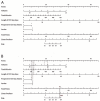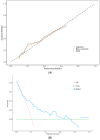Epidemiology and Risk Prediction Model of Multidrug-Resistant Organism Infections After Liver Transplant Recipients: A Single-Center Cohort Study
- PMID: 40281777
- PMCID: PMC12024721
- DOI: 10.3390/bioengineering12040417
Epidemiology and Risk Prediction Model of Multidrug-Resistant Organism Infections After Liver Transplant Recipients: A Single-Center Cohort Study
Abstract
Objective: Accurate risk stratification at an early stage may reduce the incidence of infection and improve the survival rate of recipients by adopting targeted interventions. This study aimed to develop a nomogram to predict the risk of multidrug-resistant organism (MDRO) infections in liver transplant (LT) recipients. Methods: We retrospectively collected clinical data from 301 LT recipients and randomly divided them into a training set (210 cases) and validation set (91 cases) using a 7:3 split ratio. Factors related to the risk of MDRO infection after LT were determined using univariate and multivariate bidirectional stepwise logistic regression. The model's predictive performance and discrimination ability were evaluated using receiver operating characteristic (ROC) curves, calibration curves, and decision curve analysis (DCA). Results: 56 (18.60%) patients developed a MDRO infection, including 37 (17.62%) in the training cohort and 19 (20.88%) in the validation cohort. Ultimately, five factors related to MDRO infection after LT surgery were established: ascites (OR = 3.48, 95% CI [1.33-9.14], p = 0.011), total bilirubin (OR = 1.01, 95% CI [1.01-1.01], p < 0.001), albumin (OR = 0.85, 95% CI [0.75-0.96], p = 0.010), history of preoperative ICU stay (OR = 1.09, 95% CI [1.01-1.17], p = 0.009), and length of ICU stay (OR = 3.70, 95% CI [1.39-9.84], p = 0.019). The model demonstrated strong discrimination, and the area under the curve (AUC), sensitivity, and specificity of the training set were 0.88 (95% CI [0.81-0.94]), 0.82 (95% CI [0.76-0.87]), and 0.86 (95% CI [0.75-0.98]), respectively, while for the validation set, they were 0.77 (95% CI [0.65-0.90]), 0.76 (95% CI [0.67-0.86]), and 0.68 (95% CI [0.48-0.89]). The mean absolute error (MAE) in the validation cohort was 0.029, indicating a high accuracy. DCA showed a clinical benefit within a threshold probability range of 0.1 to 0.7. Conclusions: This study developed a clinically accessible nomogram to predict the risk of MDRO infection in LT recipients, enabling early risk stratification and the real-time assessment of infection risk based on the length of postoperative ICU stay. The model incorporates five easily obtainable clinical parameters (ascites, total bilirubin, albumin, preoperative ICU stay history, and length of ICU stay) and demonstrates strong predictive performance, facilitating the early identification of high-risk patients. Future research should focus on refining the model by incorporating additional clinical factors (e.g., immunosuppressive therapy adherence) and validating its generalizability in multicenter, large-sample cohorts to enhance its clinical utility.
Keywords: liver transplantation; multi-resistant organisms; nomogram; postoperative infection.
Conflict of interest statement
The authors declare no conflict of interest.
Figures




Similar articles
-
Predicting infections with multidrug-resistant organisms (MDROs) in neurocritical care patients with hospital-acquired pneumonia (HAP): development of a novel multivariate prediction model.Microbiol Spectr. 2025 Jun 3;13(6):e0246024. doi: 10.1128/spectrum.02460-24. Epub 2025 May 15. Microbiol Spectr. 2025. PMID: 40372026 Free PMC article.
-
A nomogram for predicting early bacterial infection after liver transplantation: a retrospective study.Front Med (Lausanne). 2025 Apr 10;12:1563235. doi: 10.3389/fmed.2025.1563235. eCollection 2025. Front Med (Lausanne). 2025. PMID: 40276743 Free PMC article.
-
A deep learning model for predicting multidrug-resistant organism infection in critically ill patients.J Intensive Care. 2023 Nov 9;11(1):49. doi: 10.1186/s40560-023-00695-y. J Intensive Care. 2023. PMID: 37941079 Free PMC article.
-
OHCCPredictor: an online risk stratification model for predicting survival duration of older patients with hepatocellular carcinoma.Hepatol Int. 2024 Apr;18(2):550-567. doi: 10.1007/s12072-023-10516-x. Epub 2023 Apr 17. Hepatol Int. 2024. PMID: 37067674 Free PMC article.
-
Clinical characteristics and risk factor analysis of recipients with multidrug-resistant bacterial bloodstream infections after liver transplantation: a single-centre retrospective study.J Pharm Policy Pract. 2024 Aug 20;17(1):2390072. doi: 10.1080/20523211.2024.2390072. eCollection 2024. J Pharm Policy Pract. 2024. PMID: 39170607 Free PMC article.
References
-
- Oriol I., Sabé N., Simonetti A.F., Lladó L., Manonelles A., González J., Tubau F., Carratalà J. Changing trends in the aetiology, treatment and outcomes of bloodstream infection occurring in the first year after solid organ transplantation: A single-centre prospective cohort study. Transplant. Int. 2017;30:903–913. doi: 10.1111/tri.12984. - DOI - PubMed
-
- Viehman J.A., Clancy C.J., Clarke L., Shields R.K., Silveira F.P., Kwak E.J., Vergidis P., Hughes C., Humar A., Nguyen M.H. Surgical Site Infections After Liver Transplantation: Emergence of Multidrug-Resistant Bacteria and Implications for Prophylaxis and Treatment Strategies. Transplantation. 2016;100:2107–2114. doi: 10.1097/TP.0000000000001356. - DOI - PubMed
-
- Martin-Mateos R., Martínez-Arenas L., Carvalho-Gomes Á., Aceituno L., Cadahía V., Salcedo M., Arias A., Lorente S., Odriozola A., Zamora J., et al. Multidrug-resistant bacterial infections after liver transplantation: Prevalence, impact, and risk factors. J. Hepatol. 2024;80:904–912. doi: 10.1016/j.jhep.2024.02.023. - DOI - PubMed
LinkOut - more resources
Full Text Sources

